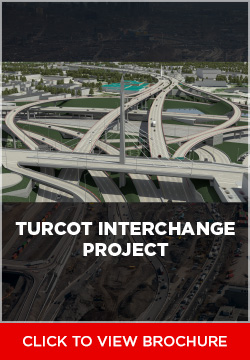 For over 50 years of service, over 300,000 vehicles per day have used the Turcot interchange, one of the most important interchanges in Québec, to commute throughout their communities. But with so much use, the time has come for the Turcot interchange to undergo a rebuilt so that Quebecers and businesses can continue to have the best traffic infrastructure they can.
For over 50 years of service, over 300,000 vehicles per day have used the Turcot interchange, one of the most important interchanges in Québec, to commute throughout their communities. But with so much use, the time has come for the Turcot interchange to undergo a rebuilt so that Quebecers and businesses can continue to have the best traffic infrastructure they can.
With completion scheduled for 2020, the Turcot interchange is a hub for road traffic in the Montréal area and an essential road link between Montréal’s Pierre Elliott Trudeau International Airport and downtown Montréal. The Turcot Project also includes the reconstruction of the Angrignon, De La Vérendrye and Montréal-Ouest interchanges, as well as adjacent sections of Highways 15, 20 and 720.
“Over time, the areas in which the Turcot Project infrastructure was originally built have been transformed, in particular with the repurposing of the Lachine Canal and the closure of the Turcot Yards,” explains Sandra Sultana, Executive Director of Major projects—Turcot interchange and Louis-Hippolyte-La Fontaine tunnel. “The project will therefore be in step with the evolution of Québec and Montréal over the past 50 years and will ensure that the Turcot area truly remains a hub for travel in the city.”
Reconstruction of the Turcot, Angrignon, De La Vérendrye and Montréal-Ouest interchanges will be carried out beneath or beside the current structures. Both Highway 20 and the railway tracks were moved north between the Turcot and Montréal-Ouest interchanges to allow future redevelopment of the Turcot Yards, with Notre-Dame Street forming an axis.
The Turcot Project will improve other aspects of the community beside transportation—it will also help improve the relationship of this major interchange with the waterfront neighbourhoods. “The project represents an excellent opportunity to rethink, renew and improve a number of aspects of the urban fabric,” says Sultana. “Establishing links between neighbourhoods, landscaping, greening of slopes and residual spaces, widening of sidewalks and developing bicycle paths are just a few examples of what is planned for this project.”
An undertaking of this size presents unique challenges for the ministère des
Transports du Quebec (MTQ) and the consortium KPH Turcot , who expertly maintained traffic flow during the dismantling and construction work, worked in close proximity to waterfronts, and coordination with a large number of partners (cities, CN, CP, Parks Canada, etc.) “Problems encountered during the completion of the project compel us to continuously seek innovative solutions, and the project team is collaborating very closely to exceed expectations,” continued Sultana.
History of the Turcot Interchange
The Turcot interchange first opened to traffic in 1967. While the new project will keep the traffic capacity as before, new infrastructure will be keeping with current standards and definitely bring benefits for motorists. For example, adding shoulders to the interchange will help limit the impact of any incidents on the road network and facilitate access for emergency vehicles.
Growing transportation needs
The Turcot interchange will be built to reduce local traffic by redirecting it in part to the routes of the greater network, while at the same time improving public transport. The project includes the redevelopment of many sections of the local road network so as to improve traffic on the main arteries for the benefit of residential areas, says Sultana.
“The [project] also prioritizes mass transit and active transportation,” says Sultana. “Nearly 20 km of reserved lanes are to be added to facilitate travel by public transit. And some 6.7 km of new multi-use trails and bike paths will also be built.”
Recent milestones
A project of this size must be completed in sections. In the fall of 2017, Highway 720 was opened, followed by moving the CN railway corridor in the summer of 2018, then Highway 15 a few months later. The MTQ recently celebrated another milestone with the end of dismantling old Highway 720 westbound and start of construction of future route 136 westbound in March, 2019.
The project is over 75 per cent complete, with over 90 per cent of the old structure’s demolition complete. During 2019, various openings are planned, in particular that of route 136 westbound, Highway 15 southbound and various ramps of the interchange.
When asked what is it like to work on a project that will impact so many people in a positive way, Sultana says the various technical, contractual and organizational challenges related to a project of this magnitude are exciting and highly stimulating. “The project has been well publicized, and the concerns of waterfront communities and users have been addressed and given high priority, which required frequent communication.”






